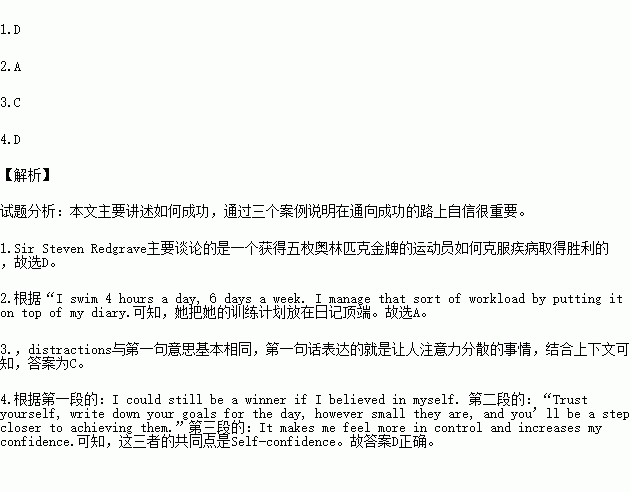题目内容
How to Be a Winner
Sir Steven Redgrave
Winner of 5 Olympic Gold Medals
“In 1997 I was found to have developed diabetes (糖尿病). Believing my career was over, I felt extremely low. Then one of the specialists said there was no reason why I should stop training and competing. That was it—the encouragement I needed. I could still be a winner if I believed in myself. I am not saying that it isn’t difficult sometimes. But I wanted to prove to myself that I wasn’t finished yet. Nothing is to stand in my way.”
Karen Pickering
Swimming World Champion
“I swim 4 hours a day, 6 days a week. I manage that sort of workload by putting it on top of my diary. This is the key to success—you can’t follow a career in any field without being well-organized. List what you believe you can achieve. “Trust yourself, write down your goals for the day, however small they are, and you’ll be a step closer to achieving them.”
Kirsten Best
Poet & Writer
“When things are getting hard, a voice inside my head tells me that I can’t achieve something. Then, there are other distractions, such as family or hobbies. The key is to concentrate. When I feel tense, it helps a lot to repeat words such as ‘calm’, ‘peace’ or ‘focus’, either out loud or silently in my mind. It makes me feel more in control and increases my confidence. This is a habit that can become second nature quite easily and is a powerful psychological tool.”
1.What does Sir Steven Redgrave mainly talk about?
A. Difficulties influenced his career.
B. Specialists offered him medical advice.
C. Training helped him defeat his disease.
D. He overcame the shadow of illness to win.
2.What does Karen Pickering put on top of her diary?
A. Her training schedule.
B. Her daily happenings.
C. Her achievements.
D. Her sports career.
3.What does the underlined word “distractions” probably refer to?
A. Ways that help one to focus.
B. Words that help one to feel less tense.
C. Activities that turn one’s attention away.
D. Habits that make it hard for one to relax.
4.According to the passage, what do the three people have in common?
A. Courage. B. Devotion.
C. Hard work. D. Self-confidence.
 天天向上一本好卷系列答案
天天向上一本好卷系列答案 小学生10分钟应用题系列答案
小学生10分钟应用题系列答案
